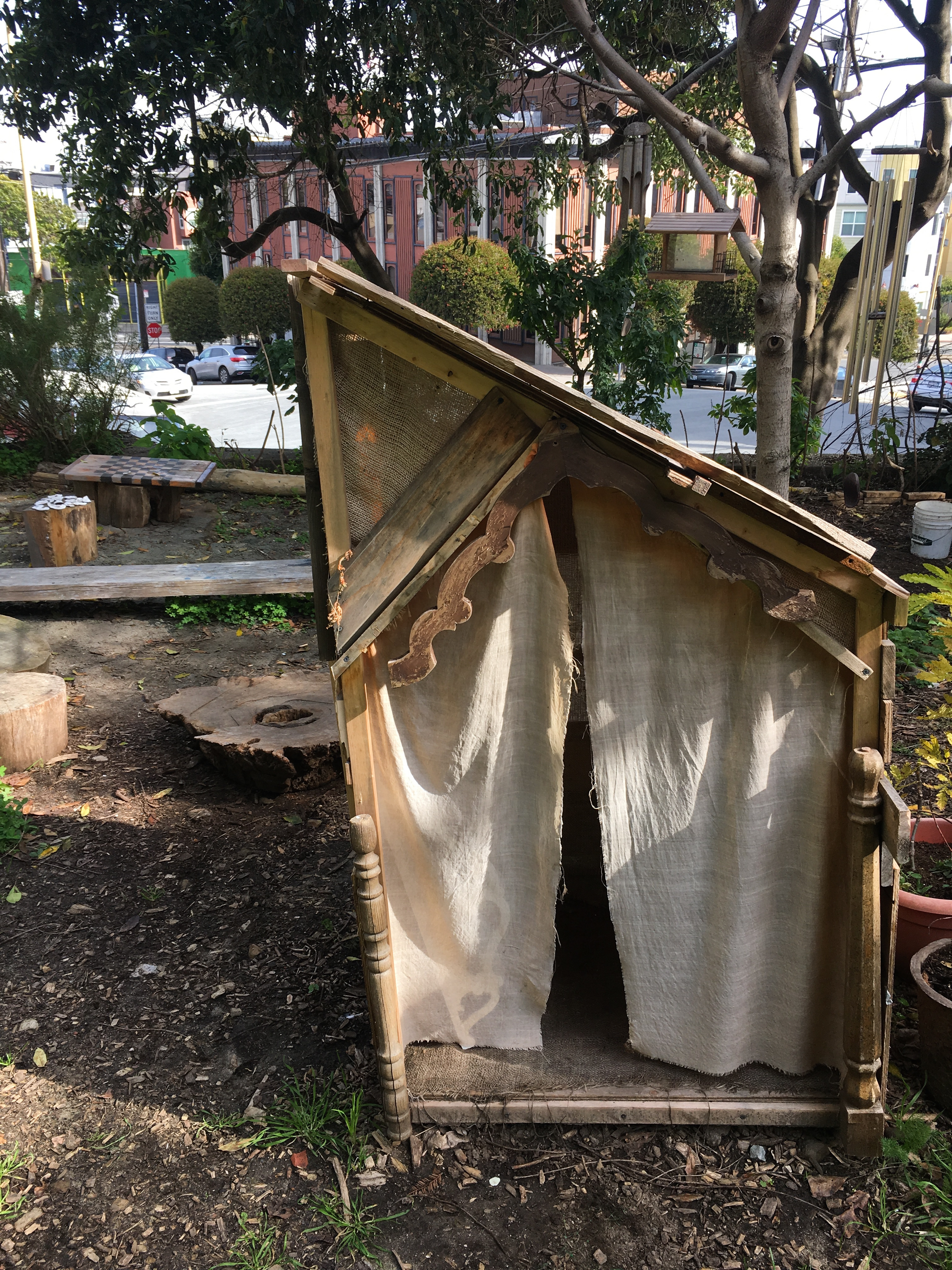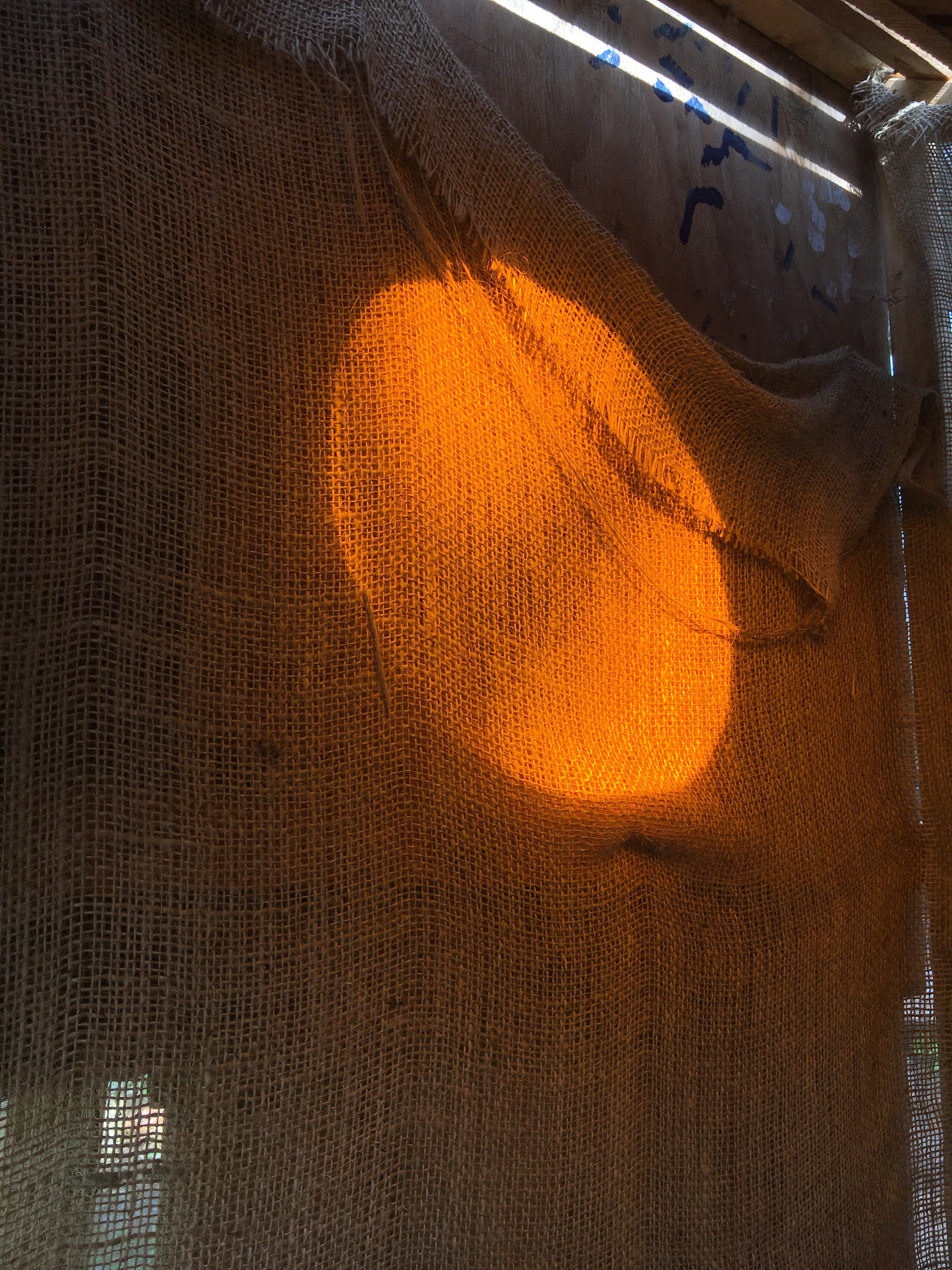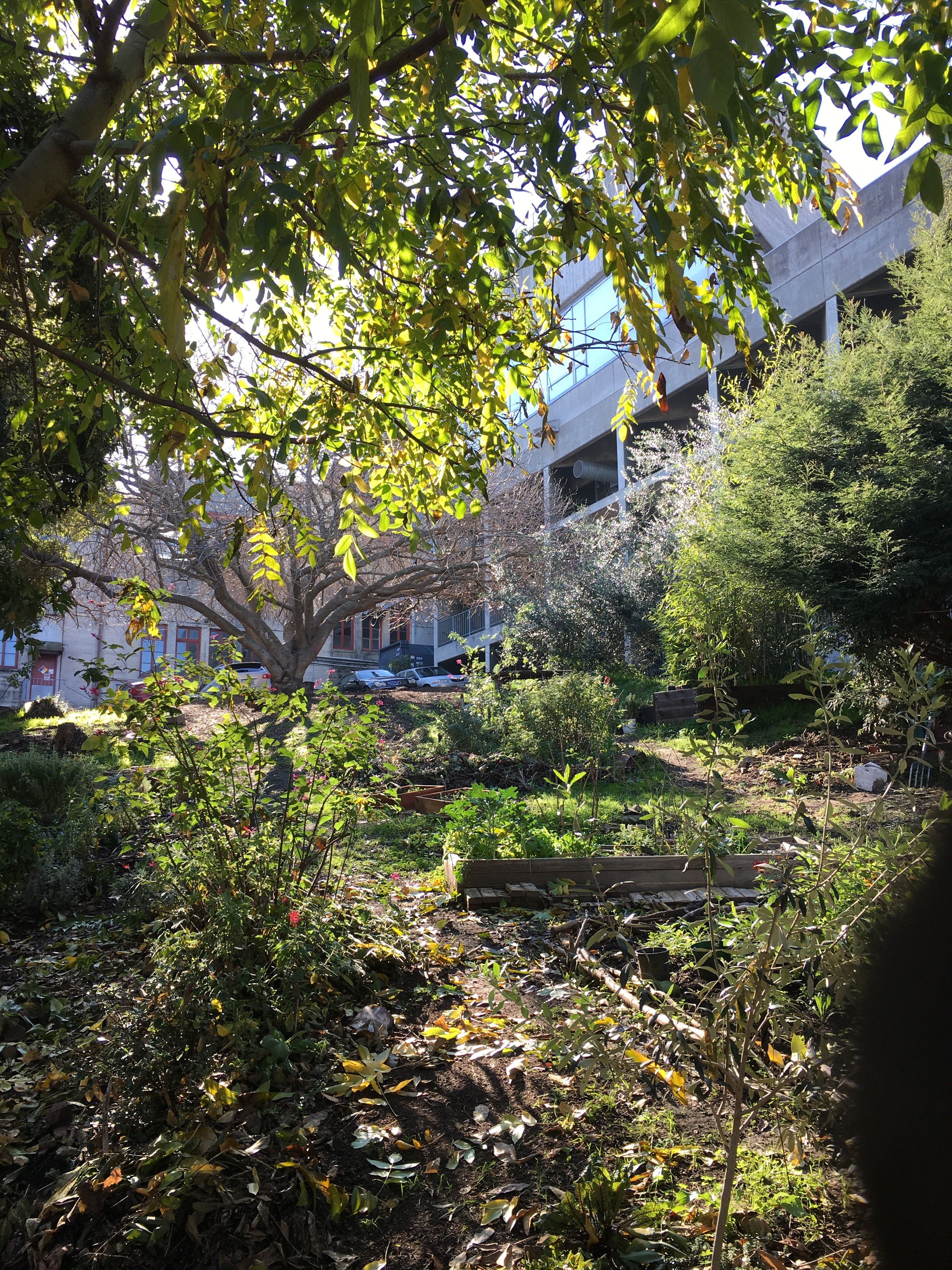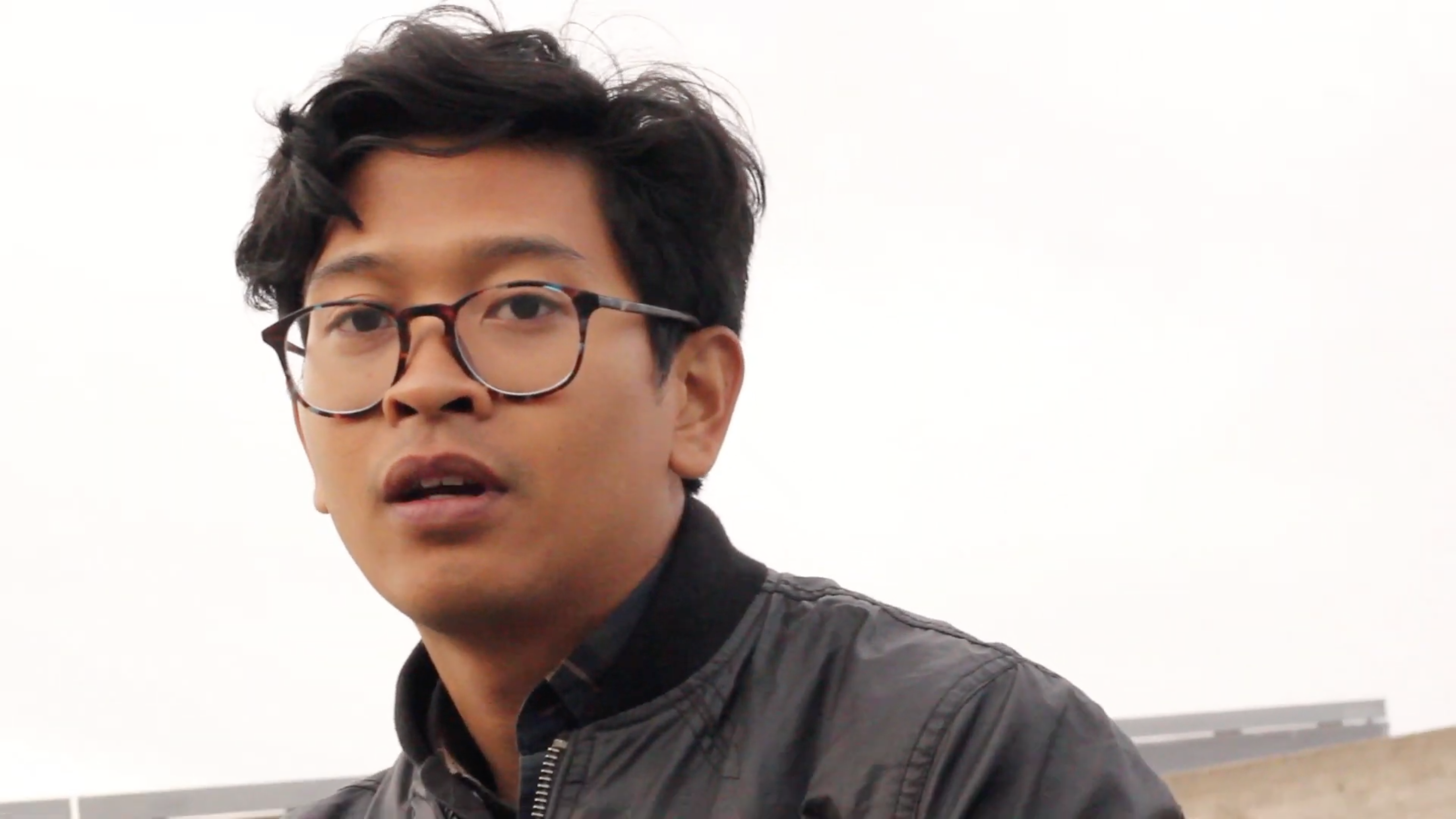
The Meadow: Sidonie Roddam
Author
Sidonie Roddam
Decade
2010s
Tags
The Meadow Community Sculpture Chairs
In the fall semester of 2016, I built a small, makeshift hut out of old chairs and secondhand wooden scraps. I made this for Ebitenyefa Baralaye’s class called Nomadic Structures, which focused on ideas surrounding adaptable shelter and mobility as sculptural practice.
When I made the hut, I was concerned with the idea of the body as a dwelling, a habitat for babies to grow in, and the need some children have for building forts, to re-create a womb-like safe space to protect themselves from outside threats, such as imagined armies, or parents. As a child I was constantly trying to create a sense of safety, as I became aware of the potential for danger in the world.
When I started school at SFAI, a similar need to cocoon myself set in. The meadow itself acted as a similar kind of space, safe from the overwhelming activity of a city and the demands of college life and sharing a dorm room with a stranger.
I think the hut was a good place for introverts, and also a good place for people to make phone calls; it had this false sense of being soundproof. It had an orange skylight; I must have been trying to replicate the sun. But I remember someone coming up to me and saying that it made them happy sitting in there; maybe it felt like you were getting a dose of vitamin D.
I was actually pregnant when I made this piece. I later had an abortion, but I had to wait a certain number of weeks before that could happen. During that interval, I was making this hut and suddenly my body had become a vessel for something to go inside of, or a dwelling for someone.
There were a lot of grad students in that Nomadic Structures class, and I was freshly twenty. In hindsight, I feel that conceptually the idea behind the project fell short. I was homesick, and thinking quite literally about rooms and homes, and the idea of making a little hut was all I could come up with. But I do find it endearing looking back, and knowing I was going through this struggle. I didn’t have anyone to talk to about it at the time. I felt like, I’m going to make a little home, although it actually ended up looking more like a doghouse.
That was my second year at SFAI and my first time living in America and, arriving in San Francisco, I was completely stunned by the homelessness situation. And I think it was probably the first time I acknowledged my privilege. I had always had this narrative that I had a somewhat difficult living situation because I’ve moved so much. I’d moved thirteen times before I was nineteen and I’d lived in three countries and had to separate from my siblings and my dad. My younger sister and I had gone to live with our mum in all these different kinds of places: a commune in Sri Lanka with no electricity, a yurt, and a converted chicken shed in Devon, on the west coast of England.
I realized at that time that I’d been carrying this narrative of being a nomad, but going to San Francisco and seeing the severity of the homelessness situation challenged that narrative. I realized how lucky I was in my living situation. You know how everyone tells themselves stories about their lives? That was a time I checked myself.
Homelessness exists in England but it’s more invisible. In San Francisco, it’s impossible to ignore. I remember feeling complicit. It’s not any individual’s fault. It’s due to the system, but I felt so upset that people had let it get this far. Eventually, the piece itself came full circle in a sadly ironic way, when the school had to get rid of the hut because they were concerned that people were sleeping in it.
For the months that the hut remained in the meadow, in true SFAI fashion, it became a pit stop where students smoked weed before class. I like that the piece took on its own role. I put it there and had no specific instructions, I suppose, in the same way that if you put out a chair, people will sit on it. I like that people found ways to use it for whatever purpose they wanted and that, for that time, it offered a habitat within a habitat.
When I made the hut, I was concerned with the idea of the body as a dwelling, a habitat for babies to grow in, and the need some children have for building forts, to re-create a womb-like safe space to protect themselves from outside threats, such as imagined armies, or parents. As a child I was constantly trying to create a sense of safety, as I became aware of the potential for danger in the world.
When I started school at SFAI, a similar need to cocoon myself set in. The meadow itself acted as a similar kind of space, safe from the overwhelming activity of a city and the demands of college life and sharing a dorm room with a stranger.
I think the hut was a good place for introverts, and also a good place for people to make phone calls; it had this false sense of being soundproof. It had an orange skylight; I must have been trying to replicate the sun. But I remember someone coming up to me and saying that it made them happy sitting in there; maybe it felt like you were getting a dose of vitamin D.
I was actually pregnant when I made this piece. I later had an abortion, but I had to wait a certain number of weeks before that could happen. During that interval, I was making this hut and suddenly my body had become a vessel for something to go inside of, or a dwelling for someone.
There were a lot of grad students in that Nomadic Structures class, and I was freshly twenty. In hindsight, I feel that conceptually the idea behind the project fell short. I was homesick, and thinking quite literally about rooms and homes, and the idea of making a little hut was all I could come up with. But I do find it endearing looking back, and knowing I was going through this struggle. I didn’t have anyone to talk to about it at the time. I felt like, I’m going to make a little home, although it actually ended up looking more like a doghouse.
That was my second year at SFAI and my first time living in America and, arriving in San Francisco, I was completely stunned by the homelessness situation. And I think it was probably the first time I acknowledged my privilege. I had always had this narrative that I had a somewhat difficult living situation because I’ve moved so much. I’d moved thirteen times before I was nineteen and I’d lived in three countries and had to separate from my siblings and my dad. My younger sister and I had gone to live with our mum in all these different kinds of places: a commune in Sri Lanka with no electricity, a yurt, and a converted chicken shed in Devon, on the west coast of England.
I realized at that time that I’d been carrying this narrative of being a nomad, but going to San Francisco and seeing the severity of the homelessness situation challenged that narrative. I realized how lucky I was in my living situation. You know how everyone tells themselves stories about their lives? That was a time I checked myself.
Homelessness exists in England but it’s more invisible. In San Francisco, it’s impossible to ignore. I remember feeling complicit. It’s not any individual’s fault. It’s due to the system, but I felt so upset that people had let it get this far. Eventually, the piece itself came full circle in a sadly ironic way, when the school had to get rid of the hut because they were concerned that people were sleeping in it.
For the months that the hut remained in the meadow, in true SFAI fashion, it became a pit stop where students smoked weed before class. I like that the piece took on its own role. I put it there and had no specific instructions, I suppose, in the same way that if you put out a chair, people will sit on it. I like that people found ways to use it for whatever purpose they wanted and that, for that time, it offered a habitat within a habitat.





















